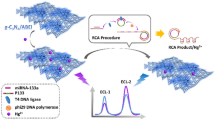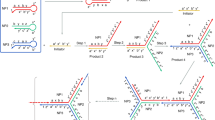Abstract
DNA strand displacement provides an effective approach to construct complex nano logic circuits. In this work, a blood group pairing logic circuit with DNA materials is designed to complete the function of blood group pairing. First, threshold gate, amplifier gate, fan-out gate and report gate are constructed on the basis of the reaction mechanism of DNA strand displacement, and then the basic computing modules of logic AND and OR are formed. In order to make any digital logic circuit translate into a dual-rail digital circuit with dual-rail strategy conveniently, the universal math model of a dual-rail digital circuit is proposed. Next, with fluorescence labeling technology, the dual-rail digital circuit of blood group pairing is converted into the DNA biochemical logic circuit consisting of fan-out gates, report gates, logic AND and OR gates. The simulation results are obtained by Visual DSD, which shows that the proposed DNA-circuit is stable, effective, and highly sensitive for blood type signals. The method of constructing blood group pairing nano logic circuit proposed in this paper also greatly reduces the difficulty of experimental operation compared with the DNA assembly technology for the same logic function, which can be applied to nano medicine diagnosis and large scale nano logical circuits in the future.
This work was supported in part by the National Key Research and Development Program of China (2016YFB0800100), in part by the National Key Research and Development Program of China for International S and T Cooperation Projects (2017YFE0103900), in part by the Joint Funds of the National Natural Science Foundation of China (U1804262), in part by the Science and Technology Project of Henan Province (202102310202), in part by the Youth Talent Lifting Project of Henan Province (2018HYTP016), and in part by Zhongyuan Thousand Talents Program (204200510003).
Access this chapter
Tax calculation will be finalised at checkout
Purchases are for personal use only
Similar content being viewed by others
References
Li, W., Yang, Y., Yan, H., Liu, Y.: Three-input majority logic gate and multiple input logic circuit based on DNA strand displacement. Nano Lett. 13(6), 2980–2988 (2013)
Cao, M., et al.: Multivalent aptamer-modified DNA origami as drug delivery system for targeted cancer therapy. Chem. Res. Chin. Univ. 36, 1–7 (2019)
Hu, Q., Li, H., Wang, L., Gu, H., Fan, C.: DNA nanotechnology-enabled drug delivery systems. Chem. Rev. 119(10), 6459–6506 (2018)
Konry, T., Walt, D.R.: Intelligent medical diagnostics via molecular logic. J. Am. Chem. Soc. 131(37), 13232–13233 (2009)
Qian, L., Winfree, E.: Scaling up digital circuit computation with DNA strand displacement cascades. Science 332(6034), 1196–1201 (2011)
Qian, L., Winfree, E.: Parallel and scalable computation and spatial dynamics with DNA-based chemical reaction networks on a surface. In: Murata, S., Kobayashi, S. (eds.) DNA 2014. LNCS, vol. 8727, pp. 114–131. Springer, Cham (2014). https://doi.org/10.1007/978-3-319-11295-4_8
Song, T., Garg, S., Mokhtar, R., Bui, H., Reif, J.: Analog computation by DNA strand displacement circuits. ACS Synth. Biol. 5(8), 898–912 (2016)
Wang, Y.F., Wang, P.R., Huang, C., Sun, J.W.: Five-input cube-root logical operation based on DNA strand displacement. J. Nanoelectron. Optoelectron. 13(6), 831–838 (2018)
Adleman, L.M.: Molecular computation of solutions to combinatorial problems. Science 266(5187), 1021–1024 (1994)
Ouyang, Q., Kaplan, P.D., Liu, S., Libchaber, A.: DNA solution of the maximal clique problem. Science 278(5337), 446–449 (1997)
Xu, J., et al.: An unenumerative DNA computing model for vertex coloring problem. IEEE Trans. Nanobiosci. 10(2), 94–98 (2011)
Collins, F.: The Language of Life: DNA and the Revolution in Personalised Medicine. Profile Books, London (2010)
Ding, B., Seeman, N.C.: Operation of a DNA robot arm inserted into a 2D DNA crystalline substrate. Science 314(5805), 1583–1585 (2006)
Thubagere, A.J., et al.: A cargo-sorting DNA robot. Science 357(6356), 1112 (2017)
Wang, X., Zhou, J., Yun, W., Xiao, S., Chang, Z., He, P.: Detection of thrombin using electrogenerated chemiluminescence based on Ru (bpy) 32+-doped silica nanoparticle aptasensor via target protein-induced strand displacement. Anal. Chimica Acta 598(2), 242–248 (2007)
Yurke, B., Turberfield, A.J., Mills, A.P., Simmel, F.C., Neumann, J.L.: A DNA-fuelled molecular machine made of DNA. Nature 406(6796), 605–608 (2000)
Zhang, P., Jiang, J., Yuan, R., Zhuo, Y., Chai, Y.: Highly ordered and field-free 3d DNA nanostructure: the next generation of DNA nanomachine for rapid single-step sensing. J. Am. Chem. Soc. 140(30), 9361–9364 (2018)
Shi, X., et al.: Programmable DNA tile self-assembly using a hierarchical sub-tile strategy. Nanotechnology 25(7), 075602 (2014)
Wang, Y., Sun, J., Zhang, X., Cui, G.: Full adder and full subtractor operations by DNA self-assembly. Adv. Sci. Lett. 4(2), 383–390 (2011)
Zhao, S., Liu, Y., Wang, B., Zhou, C., Zhang, Q.: DNA logic circuits based on FokI enzyme regulation. N. J. Chem. 44(5), 1931–1941 (2020)
Hong, F., et al.: Layered-crossover tiles with precisely tunable angles for 2D and 3D DNA crystal engineering. J. Am. Chem. Soc. 140(44), 14670–14676 (2018)
Li, J.X., Wang, Y.F., Sun, J.W.: Odd judgment circuit of four inputs based on DNA strand displacement. J. Nanoelectron. Optoelectron. 15(3), 415–424 (2020)
Author information
Authors and Affiliations
Corresponding author
Editor information
Editors and Affiliations
Rights and permissions
Copyright information
© 2021 Springer Nature Singapore Pte Ltd.
About this paper
Cite this paper
Huang, C., Wang, Y., Zhou, Q. (2021). Design of Blood Group Pairing Logic Circuit Based on DNA Strand Displacement. In: Pan, L., Pang, S., Song, T., Gong, F. (eds) Bio-Inspired Computing: Theories and Applications. BIC-TA 2020. Communications in Computer and Information Science, vol 1363. Springer, Singapore. https://doi.org/10.1007/978-981-16-1354-8_35
Download citation
DOI: https://doi.org/10.1007/978-981-16-1354-8_35
Published:
Publisher Name: Springer, Singapore
Print ISBN: 978-981-16-1353-1
Online ISBN: 978-981-16-1354-8
eBook Packages: Computer ScienceComputer Science (R0)




